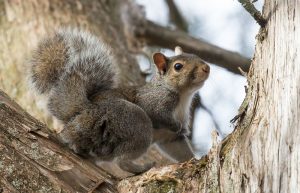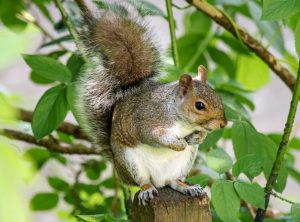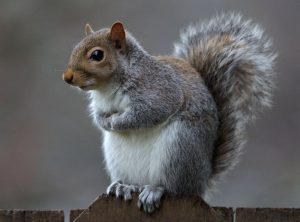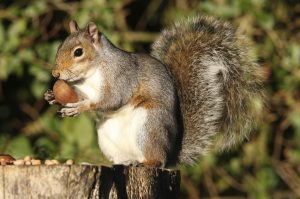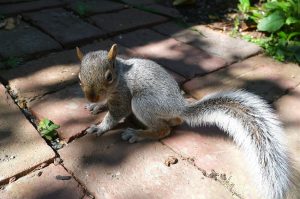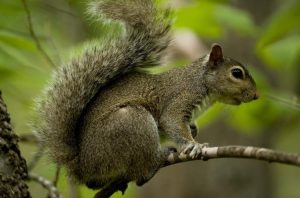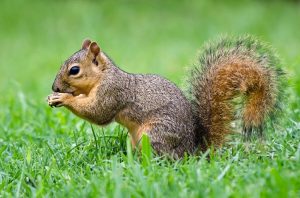Eastern Gray Squirrel
In the cool, quiet corners of coniferous forests, the Eastern Gray Squirrel darts from tree to tree with remarkable agility. With its fluffy tail and quick reflexes, this small yet adaptable mammal thrives in urban parks and dense woodlands. Despite its widespread presence, the Eastern Gray Squirrel has mastered the art of survival through clever food-hoarding, strategic nest-building, and distinctive vocalizations.
The Agile Eastern Gray Squirrel in Coniferous Forests
The Eastern Gray Squirrel is one of the most common mammals in North America. It’s found in coniferous and deciduous forests, as well as urban and suburban areas. Recognizable by its grayish-brown fur and bushy tail, this tree-dwelling rodent is known for its energetic behavior and remarkable ability to adapt to a wide range of habitats. The Eastern Gray Squirrel quickly navigates the tree canopy, jumping from branch to branch in search of food. Though it’s often seen during the day, the squirrel remains secretive and strategic, relying on instinctual behavior and strong memory to store food. By using dens, postures, and vocalizations efficiently, the Eastern Gray Squirrel has a variety of strategies enhance its survivability in diverse environments.
Scientific Classification
| Kingdom | Animalia |
| Phylum | Chordata |
| Class | Mammalia |
| Order | Rodentia |
| Family | Sciuridae |
| Genus | Sciurus |
| Subgenus | Sciurus |
| Scientific Name | Sciurus carolinensis |
Physical Characteristics: The Agile Features of the Eastern Gray Squirrel
The Eastern Gray Squirrel is a medium-sized rodent with a body length of 9.1-11.8 inches (23-30 cm) and a tail length of 7.5-9.8 inches (19-25 cm). Its gray fur and white underbelly are its most distinguishing features, although some individuals may have a darker or lighter appearance. Known for its agility, the Eastern Gray Squirrel can leap distances of up to 10 feet between trees, a skill that helps it avoid predators and travel through its forested environment. Its sharp, curved claws — adapted for gripping tree bark — allow it to climb with ease. Its fluffy tail serves multiple functions: it helps with balance during jumps, provides warmth, and acts as a shield against the elements.
Quick Information
| Also Known as | Gray or grey squirrel |
| Description | Color: Gray and brown body, white belly Length: Head to Body: 9.1-11.8 in (23-30 cm) Tail length: 7.5-9.8 in (19-25 cm) Weight: 14-21 oz (400-600 g) |
| Distribution | Eastern North America |
| Habitat | Dense woodland, hickory and oak forests, coniferous forests |
| Subspecies | 1. S. c. carolinensis 2. S. c. extimus 3. S. c. fuliginosus 4. S. c. hypophaeus 5. S. c. pennsylvanicus |
| Sound & Communication | Low-pitched ‘mehr, mehr, mehr’, for warding off predators emits “quaa” “kuk” call, the purring sound is “muk muk” |
| Lifespan | In the wild: 6-12 years In captivity: Around 20 years |
| Diet | Berries, tree buds, tree bark, nuts, acorns, and seeds |
| Adaptations | 1. Its sharp teeth are adapted to break nuts and hard seeds 2. Its ability to jump from one tree to another is an adaptation to hide and run from predators |
| Predators | Raccoons, snakes, feral cats, weasels, foxes, dogs, owls, bobcats, and African harrier-hawks |
| IUCN Conservation Status | Least concern |
Behavior and Diet: A Strategic Planner in the Forest
Eastern Gray Squirrels are known for their clever food-hoarding behavior. They gather acorns, nuts, seeds, and tree buds, storing them in hidden locations, known as “caches,” to ensure they have enough food to survive the winter months. They rely on their sharp memory to retrieve these stores, though they sometimes forget where they’ve hidden them, inadvertently helping new trees grow. These squirrels are more active during the day, engaging in foraging, grooming, and territorial behaviors. Their distinctive “mehr, mehr, mehr” call is often used to warn other animals of danger, while their purring sounds signal contentment. When faced with danger, they use postures such as tail flicking or a stiffened stance to intimidate predators. These behaviors are essential for survival, especially when navigating the challenges of urban environments or dense forests.
Mating, Reproduction and Life Cycle: Raising the Next Generation of Squirrels
Eastern Gray Squirrels breed twice a year, typically in late winter and mid-summer. Males follow females during their estrus stage, and after a brief copulation period, the female gives birth to 2-4 young after a gestation period of around 44 days. The babies are born blind and hairless but grow rapidly. At around 7-10 weeks old, they are weaned, and by 9 months, they reach adulthood. Males reach sexual maturity at 11 months, while females mature slightly earlier, at around 5.5 months. The survival rate of young squirrels is low, with only 15-25% reaching their first year, but once they survive this initial period, their survival rate jumps to 50-70%.
- Two yearly phases mating seasons: December to February and May to June
- Adult males start to follow females when the latter enter their estrus stage.
- The copulation period is for 30 seconds maximum — After that, the females’ vagina closes itself.
- After a gestation period of 44 days, 2-4 young squirrels are born in each litter.
Nests and Dens: Creating Safe Havens for Survival
The Eastern Gray Squirrel builds its nests, known as dreys, high in the branches of trees, often in dens found within tree cavities or canopies. These dens provide shelter and protection from predators, especially during the cold winter months. The construction of a drey involves collecting leaves, twigs, bark, and other materials that create a sturdy structure, lined with softer materials like moss or feathers to keep the young squirrels warm. In addition to the main drey, squirrels also create secondary nests, or fallback dens, in nearby trees or hidden locations in case the primary nest is compromised. These dens are integral to their survival, providing a safe retreat in cold weather that allows them to regulate their body temperature.
Life-cycle
Newborn squirrels are blind and weigh around 0.4 oz (14 g) and they do not have any fur on them. Around 7th week, they are weaned by their parents until the tenth week when they are no longer a juvenile. It is around 9th months, they are called adults. Male squirrels are sexually active when they are 11 months old and for female, maturity comes around 5.5 months.
Life Expectancy, Survival Rates and Lifespan: The Resilient Journey of the Eastern Gray Squirrel
The Eastern Gray Squirrel is not only agile but also surprisingly versatile in its survival capabilities. Capable of reaching speeds of up to 19 miles per hour, it can outpace predators with impressive speed. In addition, the squirrel is skilled in swimming, able to cover distances of up to one mile if necessary. While the average life span of a gray squirrel is just 18 months, the potential for survival increases significantly after the first year, where 50 to 70 percent live on.
Gray Squirrels can live up to 4 years, though reaching such an age is rare. Only about 1 percent of squirrels survive past five years. Unfortunately, the early years are the most perilous. Only 15 to 25 percent of young squirrels making it past their first year, with the remainder falling prey to predators or succumbing to disease. This high mortality rate underscores the challenges these small but resilient mammals face throughout their lives. Despite their relatively short life spans, their ability to reproduce quickly and maintain healthy populations ensures the persistence of this species in various habitats.
Conservation and Challenges: How Eastern Grey Squirrels Adapt in a Changing Environment
The Eastern Gray Squirrel is listed as a species of “Least Concern” by the IUCN, due to its wide distribution and adaptability. However, these squirrels face challenges from predators such as raccoons, hawks, bobcats, and foxes, as well as the effects of habitat destruction in urbanized areas. In some regions, non-native species, such as the Fox Squirrel, compete with the Eastern Gray Squirrel for food and nesting sites. Despite these challenges, the Eastern Gray Squirrel’s ability to thrive in diverse environments, from city parks to forested areas, ensures that it remains one of the most successful and recognizable species in North America.
Interesting Facts
- Some males despite reaching the adult state, cannot become sexually mature if they stay with male alpha squirrels. Females also, despite reaching the reproductive age, often start mating after they become 1.5 years of age.
- They have been a popular food delicacy for Native Americans as well as modern Americans but according to doctors consumption of these squirrels is detrimental for human brains.
- The Latin name ‘carolinensis’ is given to indicate that the species is first recorded in Calorina.
Summary: The Resilient Eastern Gray Squirrel
The Eastern Gray Squirrel is a resilient and adaptable mammal, thriving in a wide range of habitats from urban areas to dense woodlands. Its agility, strategic food-hoarding habits, and ability to adapt to different environments have made it one of the most successful mammals in North America. Though it faces threats from predators and habitat loss, its widespread presence and ability to thrive in diverse conditions make it a fascinating species to observe and study. As the Eastern Gray Squirrel continues to evolve and adapt to a changing environment, it serves as a reminder of the incredible resilience of wildlife.
References
- https://animaldiversity.org/accounts/Sciurus_carolinensis/
- http://naturemappingfoundation.org/natmap/facts/eastern_gray_squirrel_712.html
- https://kids.nationalgeographic.com/animals/mammals/facts/eastern-gray-squirrel
- https://www.hww.ca/en/wildlife/mammals/eastern-grey-squirrel.html
Published on August 6th 2019 by Mark Matzeldelaflor under Coniferous Forest Animals.
Article was last reviewed on 7th December 2024.


